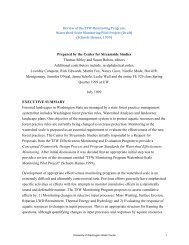Copyright 2012 Aileen M. Echiverri-Cohen - University of Washington
Copyright 2012 Aileen M. Echiverri-Cohen - University of Washington
Copyright 2012 Aileen M. Echiverri-Cohen - University of Washington
You also want an ePaper? Increase the reach of your titles
YUMPU automatically turns print PDFs into web optimized ePapers that Google loves.
videotapes <strong>of</strong> SER sessions. For this study, fidelity for SER was high, with 98% <strong>of</strong> essential<br />
elements, including a discussion <strong>of</strong> dose, side effects, client concerns about the medication, and<br />
compliance, covered during sessions.<br />
Procedure<br />
Participants were assessed for initial eligibility including the presence <strong>of</strong> Criterion A<br />
trauma exposure, presence <strong>of</strong> PTSD symptoms, and other inclusion/exclusion criteria via<br />
telephone screening. Potentially eligible participants were invited for an in person assessment.<br />
An independent evaluator (IE) who was blind to treatment condition, administered standardized<br />
diagnostic interviews (PSS-I, SCID-IV). Participants also completed pre-treatment self-report<br />
measures (BDI, STAI, DES). During the informed consent procedure, in addition to providing<br />
consent to participate in the treatment study, participants indicated their interest in being<br />
contacted to participate in a research study involving psychophysiological responses in PTSD.<br />
Potentially interested participants were contacted, provided an overview <strong>of</strong> the study, and<br />
scheduled for a session. Participants were told that that they would complete the study twice;<br />
before and after treatment, with the participants completing the study before session 1 and<br />
following session 10 <strong>of</strong> acute treatment. After providing a description <strong>of</strong> the nature <strong>of</strong> the study<br />
and completing a separate informed consent process for the study, the participant's vision was<br />
assessed using a standard Snellen eye chart (1962) and, after fitting the individual with Bose<br />
headphones (Model TP-1A,) hearing was assessed by presenting the series <strong>of</strong> 30 and 60 dB tones<br />
used for PPI.<br />
Across participants, to control for order effects, the administration <strong>of</strong> the PPI and AB<br />
tasks was counterbalanced. To set up the AB task, participants sat in a dimly lit room at a<br />
viewing distance <strong>of</strong> 35 cm away from the monitor. Next, participants were instructed to identify<br />
25
















